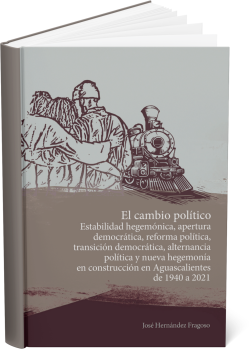THE POLITICAL CHANGE: Hegemonic stability, democratic opening, political reform, democratic transition, political alternation, and new hegemony under construction in Aguascalientes from 1940 to 2021
Synopsis
Political change is a polysemous theoretical concept that designates the process of transforming one type of political regime into another, which can be from a democratic one to an authoritarian one, or vice versa, based on the influence of structural variables, such as the economy and culture, but also of particular, subjective, and qualitative political circumstances and characteristics, such as, for example, a coup d'état or the influence exerted by groups and social movements on political processes, up to the charisma of a figure. If the variables at play are considered, it implies a complete and complex transformation that involves, in action and thought, most of the elements of the political system, from the "tangible" ones, such as parties, corporations, unions, and institutions, to the abstract ones, such as ideologies, beliefs, traditions, norms, values, among others.
The type of political transformation we are interested in and will validate in this study is one conditioned by structural or political variables, through which a regime seeks or establishes democratic forms for the exercise of power, which also allow for citizen participation in public decisions, equity and equality in social development and political competition, as well as social justice, among other elements that result in benefits such as social and political stability, the common good, respect for human rights, accountability, the right to information, the alternation in the exercise of power, and governability, among the most valued for democratic life.
Despite the polysemy and broad application of the concept of political change, in this study we have decided to apply it to the national context and the local context of Aguascalientes, as it can help us theoretically understand how we have transitioned from a political status in which the hegemony of a party lasted for more than six decades, to another in which political forces have alternated peacefully in power or in opposition. The intention of this analysis is to contribute to the debate regarding the variables that have made possible the development of a political change process in our modest local space, if we may use the term, to transition from an authoritarian, exclusionary, and repressive regime to one where the phenomenon of alternation in the exercise of power is a common occurrence generated based on the citizens' decision.
At the macro-historical level in Mexico, we have witnessed three major political changes that were the result of revolutions through armed struggle: in the first, there was a transition from the exercise of absolute power (monarchy) to a presidential regime with a separation of powers, supported by federalism; in the second, the federal republic was consolidated and ecclesiastical power was separated from civil power (a legacy of the colonial past) under the aegis of a liberal ideology; in the third, armed struggle was also necessary to recover and expand civil and political liberties—such as universal suffrage—and later to create institutions to promote participation, protect human rights, address citizen demands, and the right to information, such as the Federal Electoral Institute (IFE), the National Human Rights Commission (CNDH), and the Federal Institute for Access to Information (IFAI), among others; likewise, channels were opened for access to power through a party system and citizen involvement in government decisions through instruments of citizen participation and direct democracy (such as the popular consultation); but the important thing is that the results of the third transformation, although delayed, are being achieved without the Mexican people having to resort to arms once again.
The position from which we want to start suggests that the process of political change in modern Mexico began, as is natural, with a political crisis after the Mexican Revolution, which was exacerbated in the 1980s and has now tempered; although in certain periods, the process is still tense. But starting in 1990, Mexicans have been committed to a transformation similar to the so-called "third way," or Latin American, which advocates for a gradual and peaceful change from within the regime itself, with rules, pacts, and agreements, but above all, it champions universal principles: "equality, protection of the weak, freedom with autonomy, no right without responsibility, no authority without democracy." It could be said that the construction of the new political order in Mexico, or the transformation of the system, began with the political project embodied in the 1917 Constitution, which marked the beginning of a period of instability and political crisis in the regime that emerged from the Mexican Revolution, extending until the late 1930s, when Lázaro Cárdenas took control and imposed order. Precisely from the Cardenista project, we will differentiate five stages of the political change process in Mexico, on which we will base our analysis. Based on the references of those five stages, we intend to account for the process of political change in Aguascalientes, always guided by the larger process, undertaken from the national context and then transferred to the federal entities.

Downloads
Published
Series
Categories
License

This work is licensed under a Creative Commons Attribution-ShareAlike 4.0 International License.













